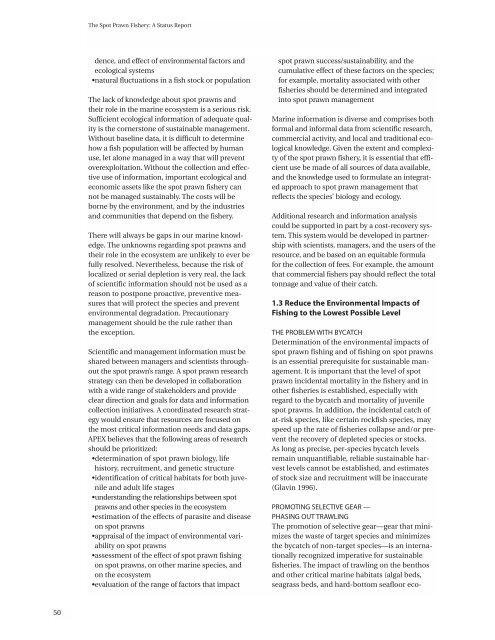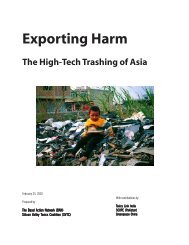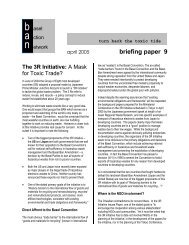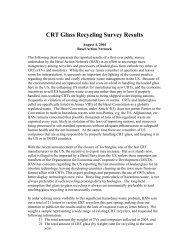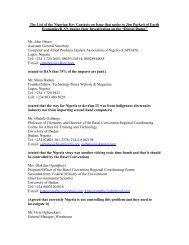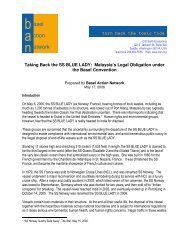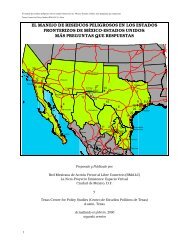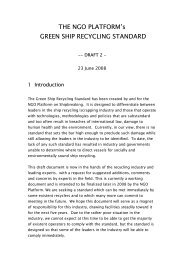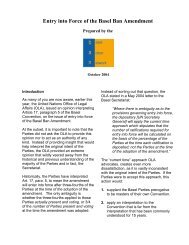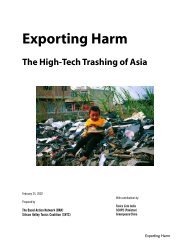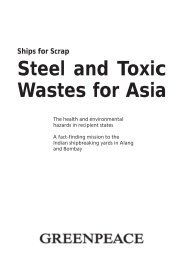The Spot Prawn Fishery The Spot Prawn Fishery - Basel Action ...
The Spot Prawn Fishery The Spot Prawn Fishery - Basel Action ...
The Spot Prawn Fishery The Spot Prawn Fishery - Basel Action ...
Create successful ePaper yourself
Turn your PDF publications into a flip-book with our unique Google optimized e-Paper software.
50<br />
<strong>The</strong> <strong>Spot</strong> <strong>Prawn</strong> <strong>Fishery</strong>: A Status Report<br />
dence, and effect of environmental factors and<br />
ecological systems<br />
•natural fluctuations in a fish stock or population<br />
<strong>The</strong> lack of knowledge about spot prawns and<br />
their role in the marine ecosystem is a serious risk.<br />
Sufficient ecological information of adequate quality<br />
is the cornerstone of sustainable management.<br />
Without baseline data, it is difficult to determine<br />
how a fish population will be affected by human<br />
use, let alone managed in a way that will prevent<br />
overexploitation. Without the collection and effective<br />
use of information, important ecological and<br />
economic assets like the spot prawn fishery can<br />
not be managed sustainably. <strong>The</strong> costs will be<br />
borne by the environment, and by the industries<br />
and communities that depend on the fishery.<br />
<strong>The</strong>re will always be gaps in our marine knowledge.<br />
<strong>The</strong> unknowns regarding spot prawns and<br />
their role in the ecosystem are unlikely to ever be<br />
fully resolved. Nevertheless, because the risk of<br />
localized or serial depletion is very real, the lack<br />
of scientific information should not be used as a<br />
reason to postpone proactive, preventive measures<br />
that will protect the species and prevent<br />
environmental degradation. Precautionary<br />
management should be the rule rather than<br />
the exception.<br />
Scientific and management information must be<br />
shared between managers and scientists throughout<br />
the spot prawn’s range. A spot prawn research<br />
strategy can then be developed in collaboration<br />
with a wide range of stakeholders and provide<br />
clear direction and goals for data and information<br />
collection initiatives. A coordinated research strategy<br />
would ensure that resources are focused on<br />
the most critical information needs and data gaps.<br />
APEX believes that the following areas of research<br />
should be prioritized:<br />
•determination of spot prawn biology, life<br />
history, recruitment, and genetic structure<br />
•identification of critical habitats for both juvenile<br />
and adult life stages<br />
•understanding the relationships between spot<br />
prawns and other species in the ecosystem<br />
•estimation of the effects of parasite and disease<br />
on spot prawns<br />
•appraisal of the impact of environmental variability<br />
on spot prawns<br />
•assessment of the effect of spot prawn fishing<br />
on spot prawns, on other marine species, and<br />
on the ecosystem<br />
•evaluation of the range of factors that impact<br />
spot prawn success/sustainability, and the<br />
cumulative effect of these factors on the species;<br />
for example, mortality associated with other<br />
fisheries should be determined and integrated<br />
into spot prawn management<br />
Marine information is diverse and comprises both<br />
formal and informal data from scientific research,<br />
commercial activity, and local and traditional ecological<br />
knowledge. Given the extent and complexity<br />
of the spot prawn fishery, it is essential that efficient<br />
use be made of all sources of data available,<br />
and the knowledge used to formulate an integrated<br />
approach to spot prawn management that<br />
reflects the species’ biology and ecology.<br />
Additional research and information analysis<br />
could be supported in part by a cost-recovery system.<br />
This system would be developed in partnership<br />
with scientists, managers, and the users of the<br />
resource, and be based on an equitable formula<br />
for the collection of fees. For example, the amount<br />
that commercial fishers pay should reflect the total<br />
tonnage and value of their catch.<br />
1.3 Reduce the Environmental Impacts of<br />
Fishing to the Lowest Possible Level<br />
THE PROBLEM WITH BYCATCH<br />
Determination of the environmental impacts of<br />
spot prawn fishing and of fishing on spot prawns<br />
is an essential prerequisite for sustainable management.<br />
It is important that the level of spot<br />
prawn incidental mortality in the fishery and in<br />
other fisheries is established, especially with<br />
regard to the bycatch and mortality of juvenile<br />
spot prawns. In addition, the incidental catch of<br />
at-risk species, like certain rockfish species, may<br />
speed up the rate of fisheries collapse and/or prevent<br />
the recovery of depleted species or stocks.<br />
As long as precise, per-species bycatch levels<br />
remain unquantifiable, reliable sustainable harvest<br />
levels cannot be established, and estimates<br />
of stock size and recruitment will be inaccurate<br />
(Glavin 1996).<br />
PROMOTING SELECTIVE GEAR —<br />
PHASING OUT TRAWLING<br />
<strong>The</strong> promotion of selective gear—gear that minimizes<br />
the waste of target species and minimizes<br />
the bycatch of non-target species—is an internationally<br />
recognized imperative for sustainable<br />
fisheries. <strong>The</strong> impact of trawling on the benthos<br />
and other critical marine habitats (algal beds,<br />
seagrass beds, and hard-bottom seafloor eco-


